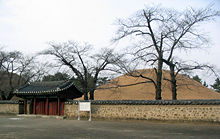- Michu of Silla
-
Michu of Silla 
Tomb of King Mich located in the neighborhood of Hwangnam-dong, Gyeongju, North Gyeongsang province, South Korea.[1]Korean name Hangul 미추이사금 Hanja 味鄒尼師今 Revised Romanization Michu Isageum McCune–Reischauer Mich'u Isagŭm Monarchs of Korea
Silla
(Pre-unification)- Hyeokgeose 57 BCE – 4 CE
- Namhae 4–24
- Yuri 24–57
- Talhae 57–80
- Pasa 80–112
- Jima 112–134
- Ilseong 134–154
- Adalla 154–184
- Beolhyu 184–196
- Naehae 196–230
- Jobun 230–247
- Cheomhae 247–261
- Michu 262–284
- Yurye 284–298
- Girim 298–310
- Heulhae 310–356
- Naemul 356–402
- Silseong 402–417
- Nulji 417–458
- Jabi 458–479
- Soji 479–500
- Jijeung 500–514
- Beopheung 514–540
- Jinheung 540–576
- Jinji 576–579
- Jinpyeong 579–632
- Seondeok 632–647
- Jindeok 647–654
- Muyeol 654–661
Michu of Silla was the thirteenth ruler of the Korean state of Silla (262-284). He was the first king of the Kim clan to sit on the Silla throne; this clan would hold the throne for most of Silla's later history. He was the son of Gudo, a leading Silla general, and the sixth-generation descendant of the clan founder Kim Alji.
During Michu's reign, the Samguk Sagi reports numerous attacks from Baekje, and does not mention any contact with the other neighboring states.
Michu's tomb is preserved in central Gyeongju today. Various legends pertain to this burial mound, which is known as the Jukjangneung, or "Bamboo chief tomb."
Achievement
Although records of his era are not abundant, he seemed to have large interests on agriculture. In 264, he visited the peasant people to encourage them during a severe famine. In 268, subjects were dispatched by Michu to hear concerns of people.
Additionally, he was quite compassionate in that he turned down the requirement of rebuilding palaces for the reason that the people shouldn't labor too much.
See also
- Three Kingdoms of Korea
- Rulers of Korea
- History of Korea
- List of Korea-related topics
References
- ^ (in Korean) 신라미추왕릉 新羅味鄒王陵 Nate / Encyclopedia of Korean Culture
Categories:- Silla rulers
- 261 deaths
- Gyeongju Kim clan
- 3rd-century monarchs in Asia
- Korean people stubs
- Korean history stubs
Wikimedia Foundation. 2010.
